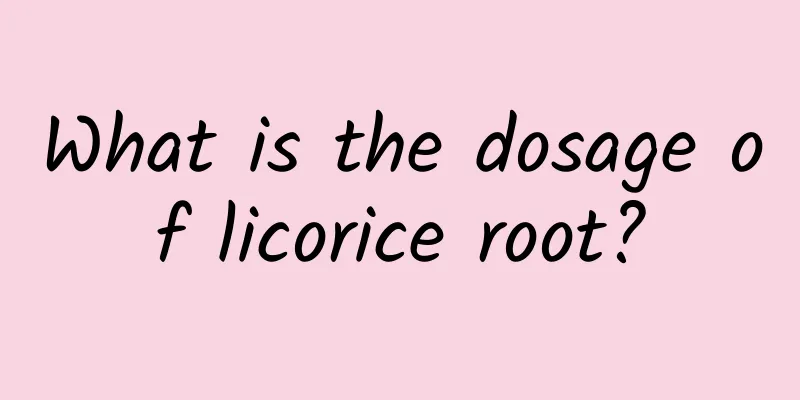What are the medicinal values of Tusanqi

|
Perhaps few people have heard of the name Tu Sanqi, but in fact Tu Sanqi is commonly known as Panax notoginseng, which is widely used in traditional Chinese medicine and is a good medicine for clearing heat and detoxifying. Many people believe that the effect of traditional Chinese medicine is not as fast as that of Western medicine. In fact, this idea is wrong. The effect of Panax notoginseng in clearing away heat and detoxifying is better than taking Western medicine or injections. So, what are the other medicinal values of Panax notoginseng? Medicinal value Medicinal properties The rhizome of this product is slightly lumpy, nearly lignified, and gray-brown on the surface; there are several roots, which are cylindrical or slightly conical, of varying thickness, hard, white or dark brown in cross section, fleshy, and loose after drying. The stem is cylindrical, 15 to 45 cm long, 2 to 5 mm in diameter, and has a green or dark green surface. It is brittle, easy to break, and has a hollow cross section. The leaves are alternate, wrinkled and mostly fall off. The complete leaves are broadly lanceolate to oblanceolate, 4 to 8 cm long, 1 to 2 cm wide, gray-green or gray-brown. Margin irregularly serrated or entire. The inflorescence is terminal, the flowers are yellow, with a faint odor and slightly astringent taste. The best ones are dry, gray-green in color, free of impurities, and with many flowers. Pharmacological Action The effect of 10% Radix Notoginseng injection on platelet ultrastructure is similar to that of thrombin[1]. Chrysanthemine has antimalarial effects and can cause hepatocyte necrosis in rabbits and rats [1,2]. Nature and flavor: sweet; slightly bitter; warm Function and indications Stop bleeding; disperse blood stasis; reduce swelling and relieve pain; clear away heat and detoxify. It is mainly used for hematemesis, epistaxis, hemoptysis, bloody stool, metrorrhagia, traumatic bleeding, dysmenorrhea, abdominal pain due to postpartum stasis, traumatic injury, rheumatic pain, sores, carbuncle, furuncle, insect and snake bites. Dosage For internal use: decoction, root 3-15g; or grind into powder, 1.5-3g; whole herb or leaf 10-30g. For external use: appropriate amount, crush the fresh product and apply; or grind it into powder and apply. Edible value and method The whole plant is harvested and processed in summer and autumn, and impurities and sand are removed. It is slightly blanched in boiling water and dried or used fresh. Nutritional Information Every 100 grams of tender stems and leaves of Panax notoginseng contains 87 grams of water, 2.1 grams of protein, 0.7 grams of fat, 8 grams of carbohydrates, 315 milligrams of calcium, 39 milligrams of phosphorus, 3.2 milligrams of iron, 2.54 milligrams of carotene, 0.05 milligrams of vitamin B1, 0.07 milligrams of vitamin B2, 0.9 milligrams of niacin, and 90 milligrams of vitamin C. The above is an introduction to the medicinal value of Tu Panax notoginseng. Now I believe you have a comprehensive understanding of Tu Panax notoginseng. The above is a detailed explanation of the medicinal value, pharmacological effects and main functions of Tu Panax notoginseng. There are many types of Chinese medicine, and Tu Sanqi is one of them. Understanding Chinese medicine will also help us maintain our health. |
<<: What are the taboos of Cuscuta
>>: What are the medicinal values of wild ginseng?
Recommend
What are the effects and functions of salt rabbit silk?
Salt rabbit silk is a plant of the flower family....
Soapberry: I am a relative of longan and longan, and I am also the "cleaning master" in the plant world
Painted by Qi Yunzhi In early spring, tender goos...
Why do I still get lung cancer even though I don't smoke or drink? Pay attention, this type of lung cancer has already targeted women
Spot check! Name a group of people at high risk f...
In such a hot day, the animals were roasted and deformed?!
Tianlan 2023 focuses on air quality and climate c...
Is it good for women to drink American ginseng?
American ginseng, also known as American ginseng,...
Amino acids were found in the samples brought back by Hayabusa 2. Does this mean that alien life has been discovered?
Recently, there were news reports that the Japan ...
What are the effects of mugwort pillow?
Mugwort is a very common plant. It is treated as ...
A 5.2-magnitude earthquake occurred in Baoshan, Yunnan! Transfer! An effective guide to escaping and self-rescue in the event of an earthquake
A 5.2-magnitude earthquake occurred in Longyang, ...
Zinc sulfate syrup
Zinc is one of the indispensable trace elements f...
Why do ducks just stand there in the rain without moving when it rains?
When it rains in the summer, most people will rus...
Can Cordyceps sinensis be chewed?
Cordyceps sinensis has strong pharmacological eff...
The efficacy and function of the pear
Chengtuo Pear is a kind of Chinese medicinal mate...
The Olympics are over, but the Olympic melons are not over yet. What the hell is "the medals are rusted"?
Olympic medals are rusty! The Paris Olympics is o...
Chickenpox, which is spread through face-to-face contact, is more contagious than monkeypox? Don’t be afraid, let’s fight acne together!
Monkeypox virus has sparked heated discussions, b...
Can the gut differentiate between real and fake sugar?
Taste buds are not only found on the tongue, but ...









